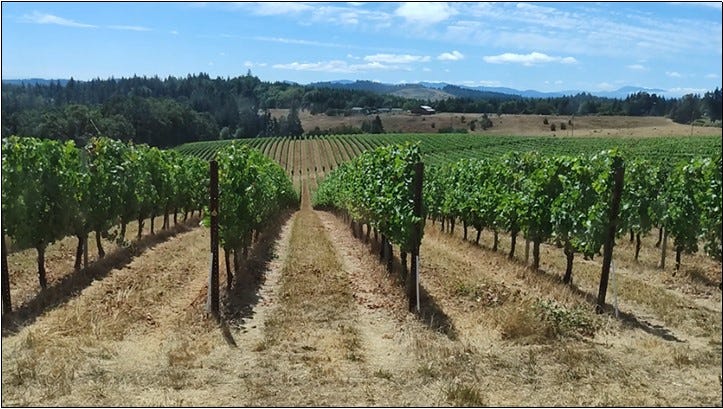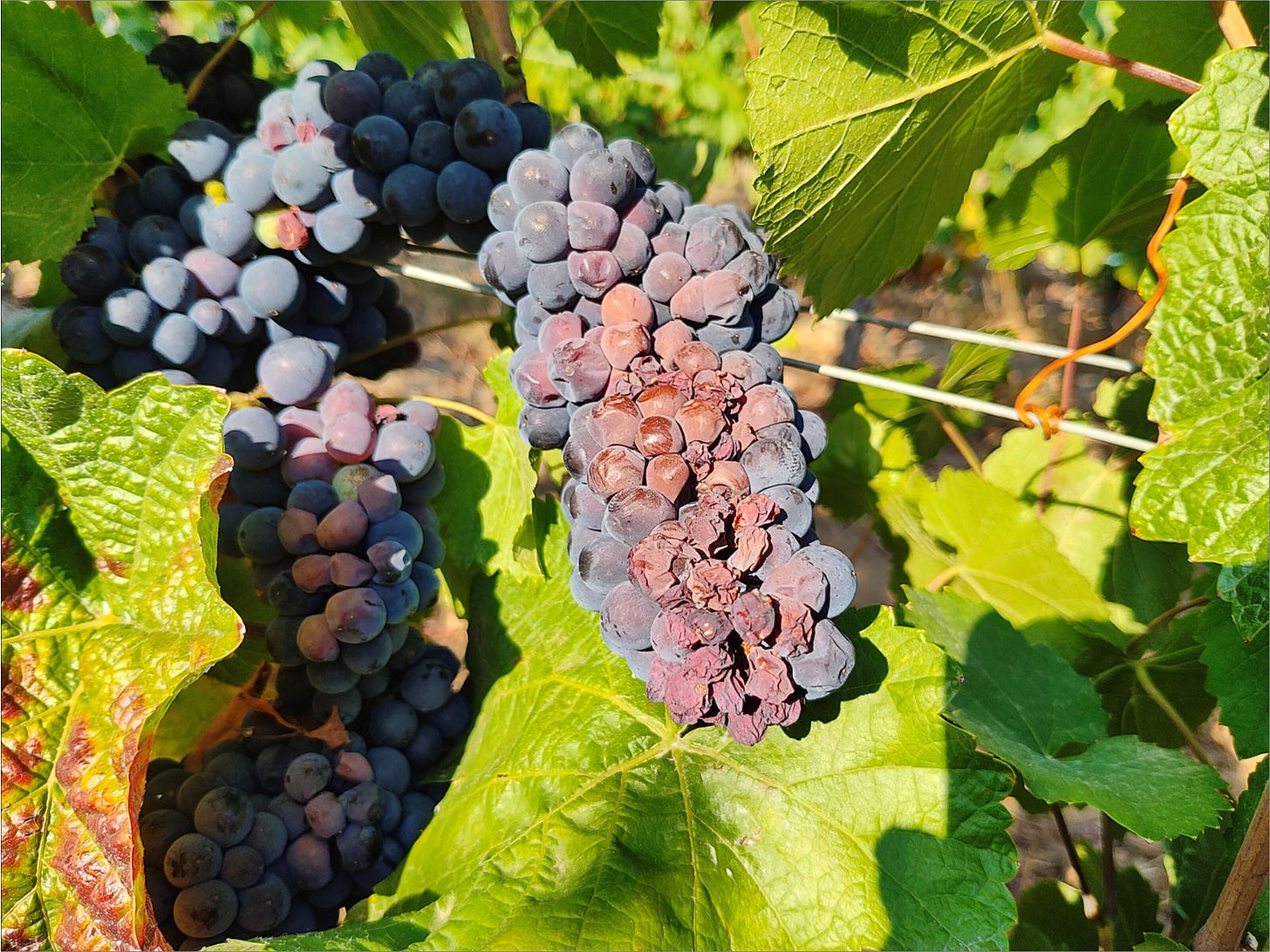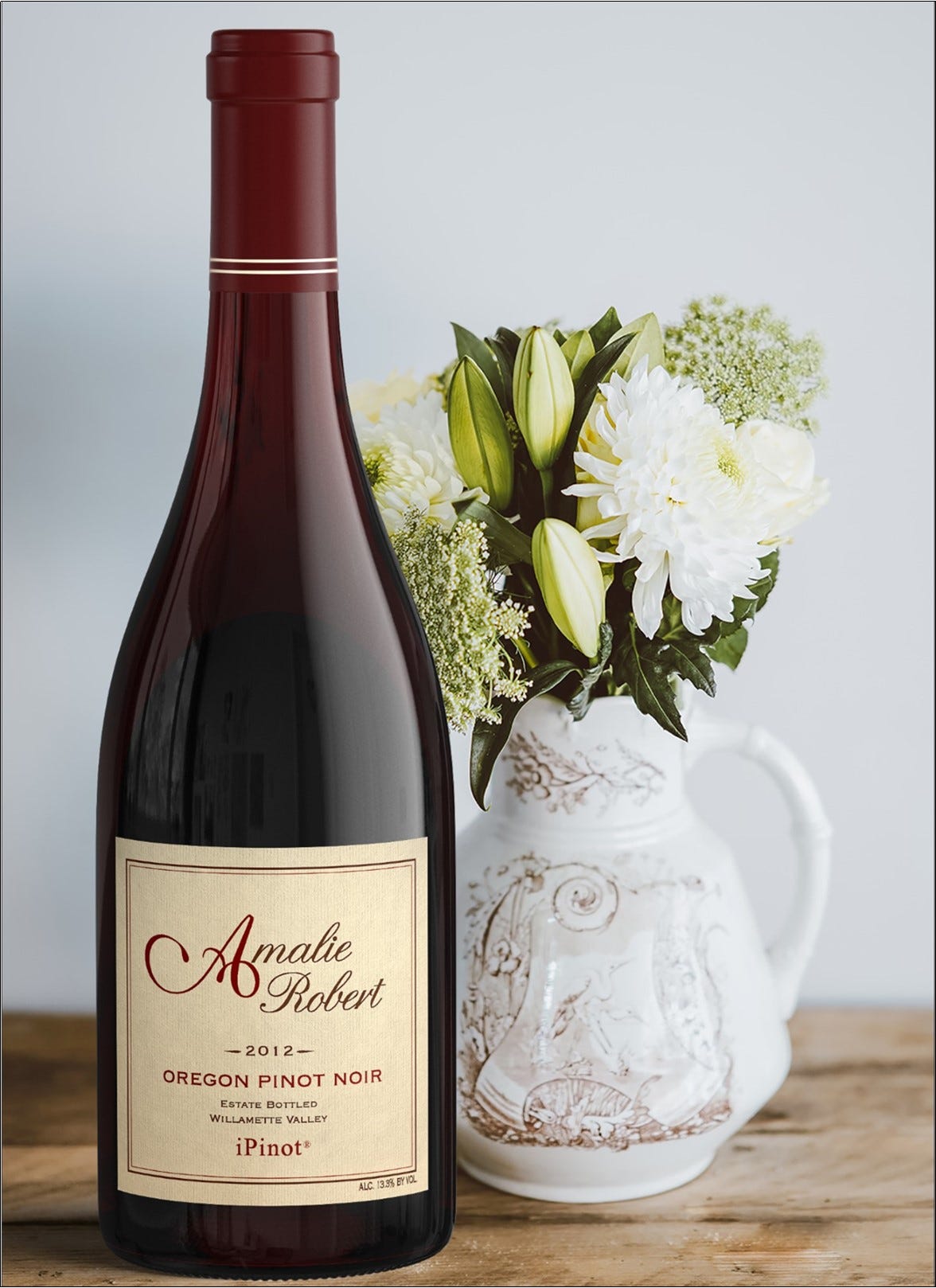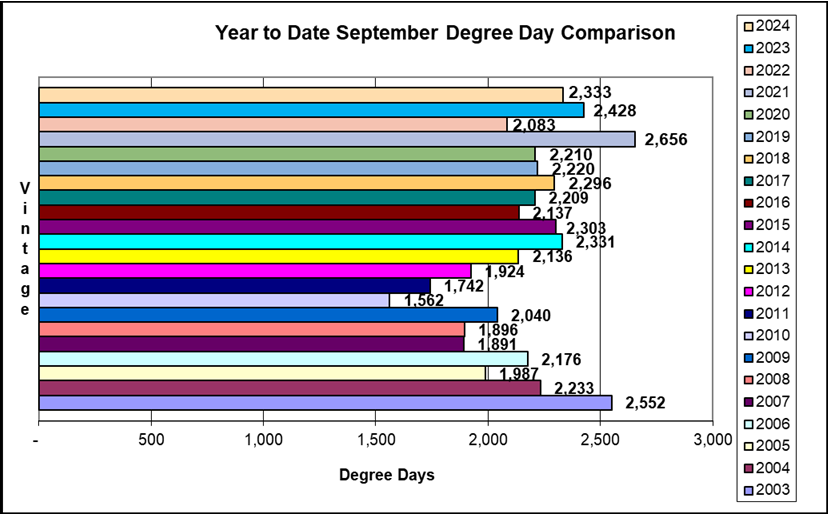Amalie Robert Estate: September Vintage Preview
Hello and Welcome,
This is the September Vintage 2024 Preview from Amalie Robert Estate. When September appears on the calendar, as it does every year just about this time, it is all over except the waiting. The torch is just starting to show its color. Most of the unfortunate, but not uncommon perils have been successfully dealt with. Several are re-runs from prior vintages, but some are new this year.
The field labor crews have come and gone, the vines are bedangled with clusters of Mother Nature’s stunning bounty nearly ready to be plucked, and the farm equipment has failed, been hauled off and repaired (and subsequently returned) then serviced for harvest. Best not to leave your equipment in the repair shop too long, or they start to befriend the other pieces of equipment and want to go back and see them!
As we suspect many people engaged in the agrarian endeavor do, we don’t ask for miracles, we depend on them. In a timely manner.
In This Communication:
The Big Picture
Celebrate 2024 with a Champagne Deconstructed Holiday 6-Pack!
The Main Story: The Good, The Bad and The Ugly
What Does This Mean and Why Should I Care?
The Numbers
Other Resources
The Big Picture
It all comes down to this. The last 30 days before harvest puts the finishing touches on the vintage. And we can say with great confidence, that if the wines reflect the amazing September weather, we are in for an EPIC Willamette Valley Pinot Noir vintage!
But it’s not over until it’s over. Once again, this year we had a little early September rain. Right around the 10th of the month we were gifted 0.83 inches of liquid sunshine. Then a bit more, about 0.37 inches on the 24th. This was after a paltry 0.08 inches of rain in July and no measurable precipitation in August. If you were a vine it was a welcome relief. If you were a cluster of wine berries, beware that scoundrel known as Botrytis!
There are two perils we must avoid in the vineyard each year. The first is powdery mildew. A mildew infection will compromise your fruit and render it unworthy to make wine. The astute winegrower will deploy canopy management techniques in May and June to allow good airflow and some sun exposure on the clusters to prevent mildew from gaining a toehold. Followed up by a damn fine hedging, or two!
Once we turn the corner into September, a new mildew outbreak is no longer a concern. As the sugar concentrations reach a certain level, the wine berries are immune to infection. Not unlike reaching a certain age, where selective hearing becomes dominant and you become immune to certain sources of irritation.
Botrytis, on the other hand, just needs a little bit of moisture to begin to grow. That and temperatures in the 70’s will foster a rapid infection. Warm rain is the last thing a winegrower wants just before harvest. Pinot Noir and especially Chardonnay are prone to Botrytis infections.
The spores are in the center of the tightly packed clusters and awaken when they are treated to warm rain. The wine berries then succumb to the infection from the inside of the cluster. Kinda like a hangnail. We have a ZERO tolerance policy for Botrytis in Pinot Noir. A little in the Chardonnay tells us it’s time to get out the harvest buckets before it gets out of control.
And thanks to Mother Nature kicking it up a few extra degrees in July, we had some wine berries compromised by sunburn. After this incident, they promptly turned themselves into raisins. They have had plenty of time to completely desiccate and now have become as hard as little rocks. Little rocks with seeds, but still…
Other than that, Mrs. Lincoln, did you enjoy the play?
iPinot® Pinot Noir 6-Pack Digital Offer
iPinot® Pinot Noir - a reserve level wine without the reserve level price. iPinot® Pinot Noir is created from reserve quality barrels of wine selected for our “Hers and His Reserves” - Amalie’s Cuvée and Estate Selection Pinot Noirs. Once the final “Hers and His Reserve” wines are blended, we have a few reserve level barrels of wine left to blend. We blend these cellar worthy barrels of wine together to create iPinot® Pinot Noir - a reserve level wine without the reserve level price.
Experience cellar worthy, Willamette Valley iPinot® Pinot Noir by Amalie Robert Estate. We are offering select vintages of iPinot® Pinot Noir for our 6-Pack Digital Offer!
Did you know we have a Book Club? Yes, in fact we have two. A White and a Rosé, join today!
The 2022 Book Club White earned 93 points and the #10 spot on Wine Enthusiast’s Top 100 Best Buy Wines for 2024!
"What a stunning wine for such a reasonable price. Its sweet floral note suggests sweet pea flowers, honeysuckle and white clover, with additional aromas of lemon tea and wet stones. The flavors suggest bergamot and lemonade, with a hint of mint. Blazing acidity lights the path to white wine satori." - Michael Alberty, Wine Enthusiast
If your plans have you somewhere other than the Willamette Valley, the Big Blue Button can co-locate your wines with YOU!
We suggest a UPS or FedEx drop point to allow you to pick up your wine at your leisure. It's better on the A-List. A-List members receive a 10% discount on any 1-11 bottle purchase, a 20% discount on a 12-bottle case purchase, and domestic ground shipping is always included with a case. Please email Dena for shipping options to Alaska and Hawaii.
The Main Story: The Good, The Bad and The Ugly
The advantage we have in growing our own wine, is that we know what is growing in our vineyard waiting for us. We don’t have to receive a harvest bin of grapes to find out that there was sunburn, desiccation or Botrytis. We already know all of that, and more importantly, we can develop harvest mitigation strategies to leave it out there.
As we move through September the wine berries continue to build aroma and flavor in the skins. Inside the wine berry, sugars are accumulating and acid is dropping. This is all good, and as it should be. However, with each passing day, the Botrytis compromised clusters continue to degrade. They are not good, and certainly are not going to get any better. But there they are all hanging out there together. The good, the bad and the ugly.
The first part of our winemaking Hazard analysis and critical control points (HAACP) is to deploy humans to harvest our wine berries, not machines. The harvest crew gets a brief bit of training each morning about what clusters to pick (from where) and what to leave on the vine. They do their best, bucket by 20 pound bucket getting it to the harvest trailer.
Once the buckets make it to the harvest bins, we take it from there. This is our first sort in the field and the sorting rule is simple. If you would not put it in your mouth and eat it, then throw it out.
You can try this at home, without having to own a vineyard. Just buy a 2 pound clamshell package of strawberries and leave them on the counter for about a week or two. When you are ready to make your morning strawberry-banana smoothie, you will most likely notice that some of those strawberries are not worthy. It is at this juncture you will apply your own HAACP and throw out the compromised fruit.
Machine harvesters are not so selective. If it was growing on the vine, it is most likely in the harvest bin, or fermenter. Think Minestrone soup. What IS that!?
We were cherry farmers our first year back in ‘99, until we got the cherry trees cleaned off of our vineyard. Montmorency pie cherries they were, and they were machine harvested by clamping onto the trunk and shaking the bejesus out of the tree. And whatever fell out of the tree, along with the dazed and confused cherries, was put into the harvest bin. Don’t get us wrong, we are not Luddites. But we believe humans do a far superior job at harvesting our wine berries.
What Does This Mean and Why Should I Care?
Just because a dog barks at you, doesn’t obligate you to bark back.
Growing wine involves some difficult decisions from time to time. We grew all of those clusters, and it is a sad feeling to see they are not all just perfect exemplars of the vintage. Some of them will not be harvested. At this point, it is time to look in the mirror and remind ourselves that we are growing wine, and some of these clusters were conquered by the terroir. Other clusters represent the very best the vintage has to offer. Just be glad it wasn’t the entire vineyard. Or that you were growing the Irish Lumper…
The Numbers
How do you tell an accountant from a lawyer? Give them each a set of numbers to add up and ask them what the total is. The accountant will give you an accurate count. The lawyer will ask you what you want the count to be.
Some of you may have missed the August Climate Update. Due to situations beyond our control (as farmers, we had to get used to that), the August Climate Update was not sent in a timely manner. However, you can read that riveting post on Substack.
Here are a couple of numbers we do not often speak about, Brix and pH. As far as chemistry goes, these two measurements of your pre-fermented juice will get you where you need to go. Brix is easy – it measures the concentration of sugar in a given amount of liquid. pH is a bit more involved, but it essentially measures the acidity of a solution, like unfermented juice.
Practically speaking, we use Brix as a guidepost to harvest. Here is a bit of winemaker math: Brix x 60% gives you approximate alcohol in finished wine. For example, 20 Brix returns 12% alcohol, while 25 Brix returns 15% alcohol. If you want lower alcohol wine, harvest at lower Brix. If you want lower Brix at harvest, cut a shorter canopy. Good to know!!
pH is a bit more difficult to influence. As the wine berries ripen, their acids decrease causing their pH to rise. For example, early in The Great Cluster Pluck, we might see 20 Brix and pH come in around 3.30, then as we get to the bitter end, we may be running around 25 Brix and pH 3.55 (which is actually sweeter, not bitter). The end goal is a microbially stable wine with a pH at 3.70 or less.
So, logically, lower alcohol wines typically have lower pH and therefore are more microbially stable. However, they may have NOT been allowed enough time on the vine to fully ripen and subsequently are bland, lacking any varietal character whatsoever. And therein lies the rub. The goal is an enjoyable wine, that is also microbially stable. If it were easy, everyone would be doing it.
And now for the weather, which we have absolutely no control over whatsoever.
We recorded 407.0 Degree Days for the month of September. The high temperature for the month was 100.0 degrees recorded on September 5th at 3:36 pm, and the low temperature was 40.5 degrees recorded om September 29th at 7:00 am. With the exception of the 2003 vintage, 400 Degree Days in September is pretty farming nice. Maybe a bit on the high side, but man what a ride!
This brings the 2024 growing season total to date to 2,333.5 Degree Days. Maybe a little bit over the line, but we will take it.
September rainfall was a total of 1.48 inches. Total rainfall for the 2024 growing season now stands at 7.34 inches.
Kindest Regards,
Dena & Ernie
Other Resources
Visit our Website
Visit the FLOG Archive
Take the Amalie Robert Tour
Shop Amalie Robert Direct
Download your FREE Willamette Valley sub-AVA Guide
Alaska Airlines Wines Fly Free


















